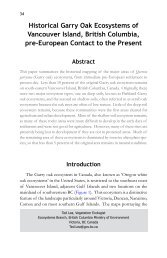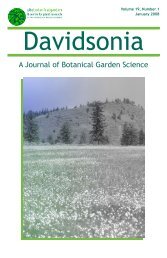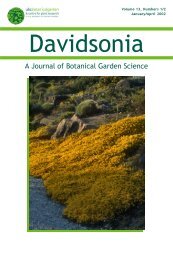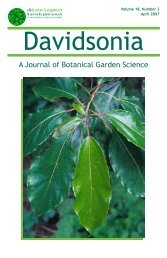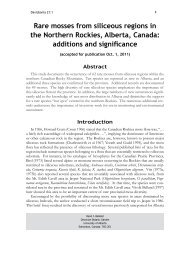pdf wkg Dav.14-14 - Davidsonia
pdf wkg Dav.14-14 - Davidsonia
pdf wkg Dav.14-14 - Davidsonia
You also want an ePaper? Increase the reach of your titles
YUMPU automatically turns print PDFs into web optimized ePapers that Google loves.
<strong>Davidsonia</strong> <strong>14</strong>:4<br />
111<br />
Autumn Colours – Nature’s Canvas is a Silk Parasol<br />
The Adaptive Value of Autumn Foliage<br />
Abstract<br />
The variety and widespread nature of leaf colour change in autumn has led to<br />
investigation of the biochemical pathways and compounds responsible. The synthesis of<br />
bright red colouration initiated by longer nights prior to leaf abscission in deciduous<br />
species points to some adaptive value for this expensive ephemeral trait. It is<br />
hypothesized that during the breakdown of the unstable chlorophyll and the dismantling<br />
of the nutrient-rich photosynthetic apparatus, red anthocyanins provide a more<br />
biochemically parsimonious alternative to the elaborate xanthophyll system. This<br />
alternative enables leaves to screen out excess light energy and circumvent<br />
photooxidative damage to leaf cells, while allowing photosynthesis to persist at low rates<br />
in support of metabolic processes and phloem loading required for nutrient resorption<br />
from leaves.<br />
Introduction<br />
People continue to marvel at the spectacle of familiar green woods and<br />
local trees changing into a coat of blazing colours in autumn. Scientific<br />
investigations beginning in the 19 th century (see Wheldale 1916) have led to<br />
a very good understanding of how this occurs. Research continues today in<br />
the fields of physiology, biochemistry, and molecular genetics to further<br />
elucidate the complex signalling pathways and mechanisms involved.<br />
During the growing season, healthy leaves are green, and appear so due to<br />
the high concentrations of chlorophyll within the chloroplasts, organelles<br />
which act as microscopic factories converting water and carbon dioxide into<br />
carbohydrates and oxygen, using the energy in specific wavelengths of<br />
sunlight. Chlorophyll efficiently absorbs red and blue light during this process,<br />
but reflects or transmits the green light we observe. In autumn the chlorophyll<br />
breaks down and leaves show the yellow and orange colours of carotenoids<br />
already present in chloroplasts, but previously invisible because of the<br />
overwhelming green of the chlorophyll. In many species, new flavonoid<br />
pigments called anthocyanins are synthesized during this period imparting a<br />
Robert D. Guy and Jodie Krakowski.<br />
Department of Forest Sciences, Faculty of Forestry, University of British Columbia,<br />
2424 Main Mall, Vancouver, BC, Canada, V6T 1Z4.<br />
Corresponding author: guy@interchg.ubc.ca



